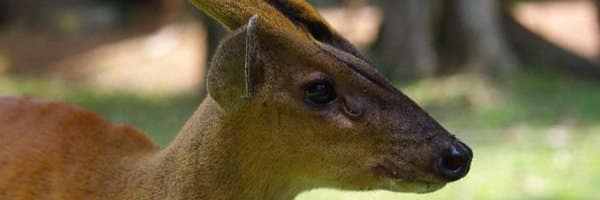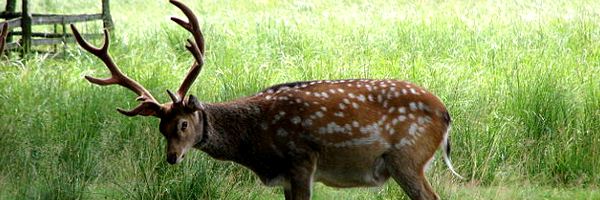White Tailed Deer – Odocoileus virginianus
As the name of this animal tells us, the White Tailed Deer is one that has a patch of white that is located around the area of its tail. They are a light brown color with shades of red in them. The exact coloring can vary depending on age and location. What is interesting is that they will turn a gray color as winter approaches. Their coloring is designed to allow them to blend into the surroundings as much as possible.
The White Tailed Deer is a small species that many people are fond off due to their cute looks. They feature very small ears and the males grow antlers. They grow with all of the points being off of one central beam. The males are larger than the females with a weight that varies by location. They range from 130 to 290 pounds.
White Tailed Deer Anatomy
The short legs of the White Tailed Deer are designed to give them speed and they can move very fast as well as gracefully. Those legs are very powerful though too and they will use them to kick and fight off predators if they have to. The hooves are designed to allow them movement in any type of terrain.
White Tailed Deer Evolution
The issue of evolution for this species of deer is very complex. When you consider that they also have many subspecies, it gives a strong indication that there has been plenty of evolving taking place over the course of time. They are very diversified and they are able to adapt to changing environments. We aren’t sure how long this has been going on, but there is evidence that deer were around millions of years ago.
White Tailed Deer Behavior
These deer are very observant and the pay very good attention to what is going on around their environment. They live in large herds so that they can have safety from predators. They do tend to stick very close to each other as long as they have lots of food to enjoy. When they are spread out it is an indication that they are struggling to find enough food.
The females are the main ones found in the herds. The males tend to stay alone but will be in territories that overlap that of the females. The only time they will really pay attention to the females is when it is time to mate. Even as young deer, the males will tend to be more isolated in the herd than the females. They don’t seem to have the same thirst for socialization as the females.
White Tailed Deer Habitat and Distribution
The White Tailed Deer is found in a variety of different locations out there. Many people assume that they are only found on the plains as that is the main place where you will see them. However, they are also found in the woods and living in the mountains. They aren’t really territorial compared to other species of deer.
Each herd or male will have a small home range that they use to migrate around in for food. It is common for the herd’s home range to overlap with each other as they are moving around for food and shelter. You can tell where deer have slept by the laid down grasses or the indentation marks in the ground.
White Tailed Deer Feeding Habits
The diet of the White Tailed Deer is considered to be more diverse than just about any animal in the wild. They are known to be able to consume more then 500 different types of plants. Of course what they can consume really depends on the region where they live. Not all of them grow in the same locations where a herd of them reside.
Different types of food can also be found in their environment based on the time of year. There are certain fruits and plant blossoms that they can only consume during particular periods of time. Grass is available to them all year long in most areas, but it may be green or brown depending on the location and the time of year.
What is really interesting though is that the White Tailed Deer doesn’t take advantage of those different foods unless they are finding it hard to get enough food. When there is plenty to choose from they will bypass some types of it in search of others. Research shows that the types of food a young deer like this is exposed to when it first starts to eat other than from the mother is what it will usually long for when there is plenty to go around.
Should the White Tailed Deer start to find that their food supplies are very scarce they will then start to consume what they come across and not give it a second thought. Survival instinct will kick in and they will make do with what is found before them.
White Tailed Deer Reproduction
When it is time to mate the males will become more aggressive. They will also travel great distances to find females. The mating season is referred to as the rut and it spans from the fall until winter. The males are going to have to fight for their chance to get to mate. Only the strongest actually get to take part in it. They will fight with each other with their antlers and the one that is victorious gets to mate with a particular doe. This process helps to keep the genetic pool strong.
The female White Tailed Deer are ready to mate when they are about two years of age. While the males do mature at that same time, it is rare for one to be strong enough to mate before it is four years old. Many of them are even older than that before they are able to do so.
What is interesting about these deer is that if their basic needs of food and shelter aren’t being met they won’t engage in the mating process. This is a way for nature to help them keep the balance of the population under control and to ensure those living have access to what they need before new life is introduced to share it.
It takes about 6.5 months after mating before the young, known as a fawn, arrive. Most of the time there is only one born per female. Sometimes there is a set of twins found out there though. The mothers are very skilled and patient with their offspring. They do their best to protect them from predators.
The mother and her fawn will remove themselves from the rest of the herd for some weeks. That way they are able to hind and to bond. The mother will have to leave her fawn to go eat though. Then she will return to offer her own milk. Fawns are born with spots but those fade as it gets older. By the time it is mature they will be gone.
White Tailed Deer Predators
The predators that they face often depend on the area where they live. They may encounter wild dogs, wolves, cougars and the fox. However, most of them are killed by humans. It may be intentionally such as through hunting. Other times though it is by accident due to cars being driven through the same areas where they live.







